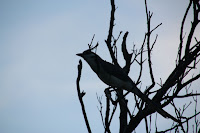 When we arrived to the paramo we saw many characteristics that describe it. The paramos are very cold; they have a lot of fog, cold breezes and wind. They are bleak and wet. The paramos develop in regions above 3,000 meters above the sea level. Temperatures can get from below zero to 30°C, this extreme changes can happen in one day. Because of the temperatures, plants and animals need to adapt and make special modifications to survive in these harsh conditions. This cold winds affect plants and trees in many ways. For example, as we go up, we saw that the trees were smaller, because the wind makes them not capable to grow higher, but the leaves have hair and are thicker, this help the tree protect and store more water and nutrients. There are not many animals, only the ones that can adapt to those harsh conditions. The most common animals are: insects, spiders, rabbits, coyotes, birds, and some reptiles.
When we arrived to the paramo we saw many characteristics that describe it. The paramos are very cold; they have a lot of fog, cold breezes and wind. They are bleak and wet. The paramos develop in regions above 3,000 meters above the sea level. Temperatures can get from below zero to 30°C, this extreme changes can happen in one day. Because of the temperatures, plants and animals need to adapt and make special modifications to survive in these harsh conditions. This cold winds affect plants and trees in many ways. For example, as we go up, we saw that the trees were smaller, because the wind makes them not capable to grow higher, but the leaves have hair and are thicker, this help the tree protect and store more water and nutrients. There are not many animals, only the ones that can adapt to those harsh conditions. The most common animals are: insects, spiders, rabbits, coyotes, birds, and some reptiles. As we were walking through the paramo, we noticed that we had to put on our jackets cause every time we had more cold temperatures and strong winds. Also because of this same reason, we really couldn't go to the volcano. Steep, trees were small, insects little bushes trees no habia frutos. fog
As we were walking through the paramo, we noticed that we had to put on our jackets cause every time we had more cold temperatures and strong winds. Also because of this same reason, we really couldn't go to the volcano. Steep, trees were small, insects little bushes trees no habia frutos. fogParamo's features makes more difficult to sustain life it also creates a new ecosystem and environment for some plants and animals. Even though it was very cold, I rather prefer cold than hot, and even though we had to change very fast temperatures it was fun going up and down the volcano and discovering some new ecosystems.











